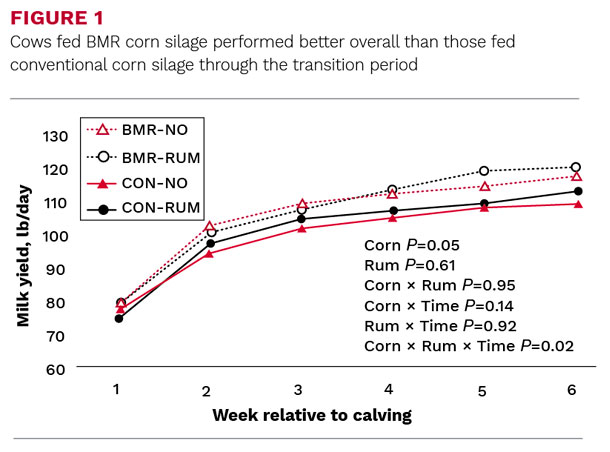The transition period from pregnancy to lactation is one of great adaptation for dairy cattle, which too often can lead to metabolic disease and consequently subpar performance throughout lactation.
After parturition, cattle enter negative energy balance, as DMI is not able to meet nutrient demands for several weeks, and body reserves are mobilized to compensate for these differences. Elevated NEFA and BHBA in the periparturient period has been linked to increased risk of several metabolic and infectious diseases, such as displaced abomasum, ketosis and metritis.
Diets for fresh cattle with higher starch content has been shown to increase diet energy content, increase postpartum energy balance and decrease circulating NEFA and BHBA, though high starch diets can have mixed results due to the increased risk of inducing subacute ruminal acidosis. Strategies to increase dietary energy through means other than increased starch could provide benefits with less risk.
In fresh cattle diets, the use of Rumensin, an ionophore that increases ruminal production of propionate through a shift in rumen bacteria population, has been shown to increase energy balance, decrease body reserve mobilization, and increase milk yield.
Another strategy to increase energy density of the diet is use of higher digestibility corn silage hybrids, such as brown mid-rib (BMR) corn silage. BMR corn silage, which has less overall cross linking within the plant structure, typically provides more digestible aNDFom to the cow than conventional corn silage.
Feeding BMR through the periparturient period has been shown to increase DMI and milk production in the early lactation period when compared to conventional corn silage. Positive effects of feeding BMR in the postpartum period also include decreased body weight (BW) loss and increased post peak milk yield.
Though much research has been conducted on these two strategies alone, little research has examined possible synergism and effects on overall metabolic status and performance in fresh cows.
To further investigate any possible synergism of Rumensin and higher digestibility corn silage, 85 multiparous Holstein cattle were moved to a tie-stall 28 days prior to expected parturition to be enrolled in our study. Cattle were fed a common close-up diet for the first seven days consisting of corn silage, chopped straw, and a grain mix, and assigned to treatment diets at 21 days before calving.
Treatment variables were corn silage type [conventional corn silage, TMF hybrid (CON) vs. brown mid-rib, BM3 hybrid (BMR)] and Rumensin supplementation [0 mg/day prepartum and postpartum (NO) vs. 330 mg/day prepartum and 450 mg/day postpartum (RUM), Elanco Animal Health, Indianapolis, IN]. At parturition, cattle were fed a fresh diet formulated to follow their assigned treatment scheme (CON vs. BMR and NO vs. RUM) through 42 DIM.
Treatment diets were formulated to be the same except for the direct substitution (DM basis) of type of corn silage and RUM/NO grain mix.
In the dataset 22 cattle were assigned to the conventional corn silage with Rumensin supplementation treatment (CON-RUM), and 21 cattle were assigned to either the conventional corn silage, no Rumensin supplementation (CON-NO), the BMR corn silage, no Rumensin supplementation (BMR-NO), or the BMR corn silage with Rumensin supplementation (BMR-RUM) treatment groups.
In the prepartum period, DMI was higher for cattle fed BMR (32.4 lb/day) than those fed CON corn silage (30.9 lb/day), while cattle fed RUM had lower intake (30.6 lb/day) than those without RUM supplementation (32.7 lb/day). Postpartum no significant differences in intake due to corn silage, RUM, or any interaction were observed.

For milk yield, however, a three-way interaction of corn silage, RUM, and time was present where cows fed BMR-RUM had the highest and cows fed CON-NO had the lowest milk yield in weeks five and six postpartum. For blood metabolites, there were no interactions of corn silage type and Rumensin.
In the prepartum period, as cattle approached calving, those fed BMR had lower NEFA than cattle fed CON, and those fed RUM had lower BHBA than cattle fed NO. Postpartum cattle fed BMR, compared to those fed CON, and cattle fed RUM compared to those fed NO, had lower NEFA and BHBA.
This project demonstrates that cattle fed BMR corn silage performed better overall than those fed conventional corn silage through the transition period. Higher intakes prepartum, as well as higher yield and more favorable circulating blood metabolites in the postpartum period, suggest these cows were in a more positive energy balance than cows fed CON corn silage, likely due to the increased digestible fiber.
Cattle fed Rumensin, despite having slightly lower intakes prepartum, had lower circulating BHBA prepartum, as well as lower BHBA and NEFA in the postpartum period. This again suggests that animals were in a better metabolic status.
Although we saw minimal statistical interactions between corn silage type and Rumensin, both use different strategies to increase the overall energy availability of the cow. The interaction seen in milk yield data suggests a potential synergism between these two strategies. In this vital transition period these strategies, alone or together, can be key to increase overall cow health and productivity through their impacts on energy availability and overall energy balance.
Sarah LaCount is a Ph.D. candidate in Dr. Overton’s laboratory at Cornell University. Thomas Overton and Mike Van Amburgh are Animal Science Professors in the College of Agriculture and Life Sciences at Cornell University.
This article appeared in PRO-DAIRY’s The Manager in July 2018. To learn more about Cornell CALS PRO-DAIRY program, visit PRO-DAIRY Cornell CALS.






